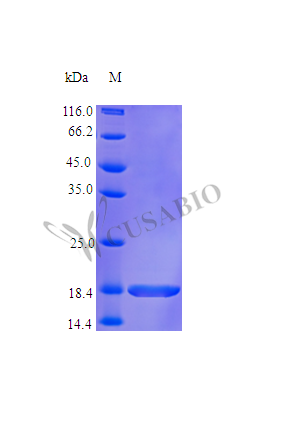Recombinant Human Fibroblast growth factor 10 (FGF10) comes from E. coli expression and covers amino acids 40-208 of the protein. This tag-free protein shows purity greater than 97% when checked by SDS-PAGE analysis. The protein appears to be fully biologically active, with an ED50 of less than 0.5 ng/ml based on thymidine uptake assays using FGF-receptor transfected BaF3 cells. This corresponds to a specific activity of over 2.0 × 10^6 IU/mg. Endotoxin levels remain controlled at less than 1.0 EU/µg as measured by the LAL method.
Fibroblast growth factor 10 (FGF10) represents a key protein in various biological processes, though it's particularly important in cell growth and tissue repair. The protein likely plays a significant role in developmental pathways and seems essential for proliferation and differentiation of certain cell types. FGF10's involvement in these processes has made it an interesting target for research into cellular mechanisms and potential therapeutic uses.
Potential Applications
Note: The applications listed below are based on what we know about this protein's biological functions, published research, and experience from experts in the field. However, we haven't fully tested all of these applications ourselves yet. We'd recommend running some preliminary tests first to make sure they work for your specific research goals.
1. Cell Proliferation and Viability Assays
This recombinant FGF10 protein is confirmed to be highly biologically active (ED₅₀ < 0.5 ng/ml) and suitable for proliferation studies in FGF receptor-expressing cells. However, the partial sequence (40-208aa) lacks the N-terminal region of full-length FGF10, which may affect heparin-binding affinity and receptor dimerization efficiency. Researchers should validate that proliferation kinetics and signaling amplitude match full-length FGF10, particularly in primary cells or complex 3D culture systems where heparin cofactor interactions are critical. The high purity (>97%) supports reliable results, but the partial nature may limit translation to more physiological microenvironments.
2. FGF Receptor Binding and Signaling Studies
The protein is appropriate for FGFR2b binding studies, but the partial sequence may alter heparin-dependent receptor activation mechanisms. Binding assays should include heparin supplementation and compare affinity constants with full-length FGF10. The extremely high specific activity (>2.0×10⁶ IU/mg) indicates proper receptor-binding domain folding, but researchers should validate that downstream signaling pathways (MAPK, PI3K) exhibit kinetics and duration comparable to full-length protein.
3. Protein-Protein Interaction Studies
This tag-free FGF10 is suitable for interaction studies, but the missing N-terminal domain may affect interactions with heparan sulfate proteoglycans and other cofactors. Studies focusing on core FGFR2b interactions are well-supported, but interactions involving the heparin-binding domain should be validated with full-length protein. The high purity minimizes non-specific binding, but the partial nature limits comprehensive interactome mapping.
4. Antibody Development and Validation
This high-purity FGF10 serves as a good immunogen, but antibodies generated against this partial sequence will not recognize N-terminal epitopes. Comprehensive antibody validation should include testing against full-length FGF10 to ensure recognition of all functional domains. The confirmed high bioactivity supports the development of function-blocking antibodies targeting the receptor-binding region.
5. Structure-Function Relationship Studies
This partial FGF10 (40-208aa) is valuable for studying the core receptor-binding domain, but cannot inform about structure-function relationships involving the missing N-terminal region. Comparative studies with full-length FGF10 are essential to determine how the truncation affects heparin affinity, receptor specificity, and biological potency. The high specific activity confirms the core domain is properly folded, but conclusions should be contextualized as representing a partially truncated form.
Final Recommendation & Action Plan
This recombinant human FGF10 partial protein (40-208aa) demonstrates exceptional biological activity and is suitable for most proposed applications with appropriate validation of its truncated nature. Prioritize confirming that key FGF10 functions—particularly heparin-dependent receptor dimerization and signaling in complex microenvironments—match full-length FGF10 in your specific experimental systems. For cell-based assays, the extremely high potency allows for low working concentrations, but include heparin supplementation to ensure proper receptor activation. When developing antibodies, supplement with full-length antigen to ensure comprehensive epitope coverage. For structural studies, the protein provides a valuable tool for analyzing the core FGF domain, but acknowledge the missing N-terminal region in interpretations. The E. coli expression produces a non-glycosylated protein, which is advantageous as FGF10 is typically non-glycosylated, but the partial sequence remains a significant consideration. Always validate critical findings with full-length FGF10 when studying complex biological contexts involving heparin interactions or tissue-specific functions.






